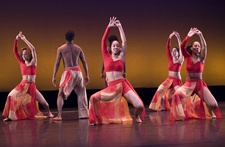I have always found the work of Fred Astaire to be relentlessly complex; with every theoretical lens, something new is revealed about the implications of his performances, his style being a cross-pollination of what Darcey Callison describes as dance “traces” of the past (minstrel shows, Vaudeville) and future (John Travolta, Michael Jackson and Napoleon Dynamite). Callison’s “(Re)tracing Fred” reveals yet another vestige of the Astaire phenomenon, and of danced masculinity in general. With his cast of dancers (Johanna Bergfeldt, Jennifer Dahl, Michael Caldwell, Louis Laberge-Cote, Ryan Lee, Jessica Runge and Shawn Newman), and the inclusion of carefully orchestrated source material, Callison explores the “traces” of Astaire’s work, situating them in the realm of gender performance. Informed by gender theorist Judith Butler`s thesis that gender is constructed, Callison unravels the performed masculinity in the different but enmeshed bodies of Astaire, disco, baroque and working-man culture. Stemming from Callison’s doctoral research, “(Re)tracing Fred” presents a series of danced arguments for the idea that masculinity is socially constructed and performed via the dancing body. What makes this idea most convincing is the cast of both men and women who successfully wear modes of constructed masculinity.
Inspired by the “man in crisis” theme of Edward Albee’s play “Why We Go To Zoos”, Callison`s opening section, “Push Comes To Shove”, performs stereotypical behaviours of what one would construe as blue-collar culture. The masculinity here is defined by a ‘fight dance’ physicality: a series of pushes, multi-limbed thrusts, wrestling and vocal grunts which build into full-bodied physicality. Accepted as masculine in this context is a symphonic bodily machismo of effort, aggression, brawling and bullying.
Transitioning into the “Inferno” section, a disco ball lowers and a display of spinning lights spatters the stage, reminiscent of John Travolta’s disco scene in “Saturday Night Fever”. Catcalls, competitiveness, freeze-framed disco poses, and originality of movement are now the signs of successful masculine behaviour. These posturing individuals take turns dominating the space, as onlookers mimic on the sidelines. Although the dancers move with individuality, the shared masculine corporeality in “Inferno” is a puffed-up chest propelled by an arrogant swagger.
Perhaps the most nostalgic section was “Fred”, which although arguably literal, was fascinating. Projected on a large screen upstage is a slowed-down version of Astaire’s “Top Hat” solo, suggestive of the debonair, tuxedo culture he emanates. A dancer’s body emerges as a silhouette against the Hollywood imagery; wearing Astaire’s garb, she looks up to him, dancing with, and mirroring him as she learns his physical constructions of masculinity. The qualities explored here are what made Astaire great: facility of movement, refined confidence, and the stylized masculine aesthetic of a suit, a top hat and a cane.
Before entering the theatre, I wondered how Callison would reconcile the problem of the mediums: how does a choreographer explore filmed dance in a real-time, ephemeral performance? Callison’s answer, which I found both visually and conceptually effective, was to shield the stage with a screen, so as to project various textual materials on the screen, and give the impression of a filmed context.
“(Re)tracing Fred” is at its heart a commentary on gender construction; Callison successfully unravels modes of performed masculinity in various contexts and dance “traces”. Still, I found social acceptance to be the guiding theme behind this work. As the sections shift to different temporal moments (from baroque to disco) it becomes apparent that a desire for acceptance ultimately fuels the construction and maintenance of gendered behaviours.
Tagged: Contemporary, Performance, ON , Toronto





